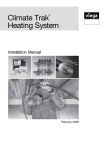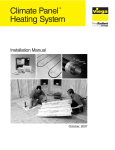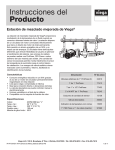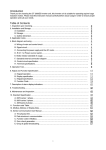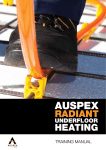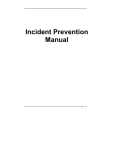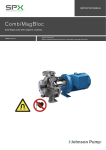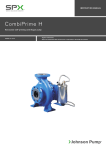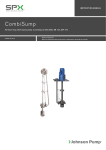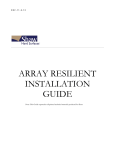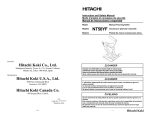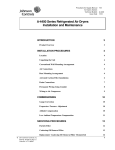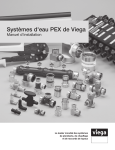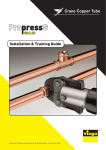Download Climate Trak® Heating System
Transcript
Climate Trak Heating System ® Installation Manual February 2009 Working with Viega is the perfect solution. Viega researches, develops, and produces complete system solutions for contractors in the technical building installation business. The components are produced at our plants or are supplied exclusively by the finest quality manufacturers. Each of our systems is developed in-house and tested under stringent quality control conditions to guarantee safety and efficient operation. By choosing to install a Climate Trak System, you have joined the ranks of heating system installers across the country who believe there is no substitute for quality. Viega has a history of bringing high quality and innovative technology to the hydronic marketplace in North America. It is the business of our engineers to research and develop complete systems that provide you the most effective and easy-to-use products available. An international company with a national commitment. In the following pages, you will be guided through the system design, layout, installation and start-up of our Climate Trak System. Viega recognizes that many of the advances in our industry have their beginnings in Europe. However, that does not mean North America deserves anything less. Therefore, we have been the pioneer in combining technology from both sides of the Atlantic into the very best plumbing and heating systems for our customers. Call 800-976-9819 for your local representative and wholesale location. Our goal is to remain in the forefront of the plumbing and heating industry well into the new century, and with our advanced products and a determination to remain the quality leader, we are convinced this accomplishment is well within our reach. Disclaimer: Systems should be protected from freezing at all times. Proper insulation or glycol mixture may be needed in system if not used for an extended period of the heating season. IM-PR-Climate Trak 0209 Welcome 2 We look forward to sharing our history in the making with you. CONTENTS APPENDIX A 1 System Overview Making a Press Connection. . . . . . . . . . . . . . . . . . . . . . . . . 30 APPENDIX B SVC Compression Coupling 3/8"- 5/8" . . . . . . . . . . . . . . . 31 1.1 Application Benefits . . . . . . . . . . . . . . . . . . . . . . . . . . . 4 2 System Design 2.1 2.2 2.3 2.4 2.5 2.6 Calculating a Materials List. . . . . . . . . . . . . . . . . . . . . . 5 Heat Loss Calculations for Floor Heating Systems Using Radiant Wizard. . . . . . . . . . . . . . . . . . . . . . . . . . 6 Calculating the Supply Water Temperature . . . . . . . . 6 Calculating the Floor Surface Temperature . . . . . . . . 7 Calculating the Pressure Drop. . . . . . . . . . . . . . . . . . . 8 Selecting a Circulator Pump. . . . . . . . . . . . . . . . . . . . . 9 APPENDIX C Recommended Tools for Installation . . . . . . . . . . . . . . . . . 32 APPENDIX D R-Value Table Floor Coverings. . . . . . . . . . . . . . . . . . . . . . 33 APPENDIX E Supply Water Temperature/BTU Output Charts . . . . . . . . 34 APPENDIX F Making a Materials List . . . . . . . . . . . . . . . . . . . . . . . . . . . . 37 3 Climate Trak/Heat Transfer Plate System Installation 3.1 3.2 3.3 3.4 3.5 3.6 Pre-installation Tip Page. . . . . . . . . . . . . . . . . . . . . . . Clearing the Bays. . . . . . . . . . . . . . . . . . . . . . . . . . . . Drilling Tubing Holes. . . . . . . . . . . . . . . . . . . . . . . . . . Attaching the Traks/Plates. . . . . . . . . . . . . . . . . . . . . Installing the Tubing. . . . . . . . . . . . . . . . . . . . . . . . . . Post-installation Tip Page. . . . . . . . . . . . . . . . . . . . . . 10 11 12 13 14 19 4 Piping and Controls 4.1 Mixing Station and Manifolds. . . . . . . . . . . . . . . . . . . 20 4.2 Single and Multiple Temperature Schematics . . . . . 21 4.3 Zone Wiring. . . . . . . . . . . . . . . . . . . . . . . . . . . . . . . . . 24 5 System Start-up 5.1 5.2 5.3 5.4 Station and Actuator Installation . . . . . . . . . . . . . . . . Purging and Pressure Testing the System. . . . . . . . Adjusting the High Limit Kit. . . . . . . . . . . . . . . . . . . . Initial Balancing. . . . . . . . . . . . . . . . . . . . . . . . . . . . . . 25 26 27 28 6 Finish Flooring 6.1 Choosing a Finished Floor. . . . . . . . . . . . . . . . . . . . . 29 3 IM-PR-Climate Trak 0209 1. SYSTEM OVERVIEW CONTENTS 1.1 A pplication Benefits Climate Traks and Heat Transfer Plates are designed for retrofit applications or in applications where the buildup above the subfloor is a concern. These types of applications are not the most efficient kind of radiant heating compared to systems such as Viega Climate Panel and Viega Snap Panel, but deliver the comfort of having warm floors and full radiant heating throughout the house. Both methods utilize ViegaPEX Barrier Tubing and attach directly to the underside of the subfloor. This is a fast, lightweight application to install and provides the comfort of radiant heat the homeowner is looking for. Climate Trak: 1. Heavier aluminum than the Heat Transfer Plates 2. Fastest installation time (does not require Groove Tube) 3. Easiest to install (Traks and tubing are installed separately, so there is no struggling with the tubing while the fastening is being done) 4. Predrilled holes for ease of fastening with screws 5. Comes in 4' or 8' long Traks that also help with installation time 6. Snap-in groove for tubing maximizes contact between the aluminum and the PEX Tubing for efficient heat transfer Heat Transfer Plates: 1. Made from thinner, more flexible aluminum than the Climate Traks 2. Comes in 20" long by 5" wide plates 3. Requires a small bead of Groove Tube down the channel where the tubing is run right before installation IM-PR-Climate Trak 0209 4 2. SYSTEM DESIGN CONTENTS 2.1 C alculating a Materials List Multipliers For Climate Traks Tubing OC 6" 8" 9" 12" 16" 18" Plate Size 4' 8' 4' 8' 4' 8' 4' 8' 4' 8' 4' 8' Tubing Multiplier Multipliers For Heat Transfer Plates Trak Multiplier .47 .23 .35 .18 .31 .16 .23 .12 .18 .09 .16 .08 2.2 1.7 1.5 1.1 .85 .75 Tubing OC Tubing Multiplier Plate Multiplier 6" 2.2 .93 8" 1.7 .70 9" 1.5 .62 12" 1.1 .47 16" .85 .35 18" .75 .31 Maximum Circuit Length ≤25 BTU/ft2 26-35 BTU/ft2 3/8" 300 ft. 250 ft. 1/2" 400 ft. 350 ft. Example: Heated Area - 1,500 sq. ft. Calculating Number of Traks 8' Climate Traks 8" O.C. # of Traks = 1,500 sq. ft. x .18 # of Traks = 270 - Sold in packages of 20: (round up to order 14 boxes) Calculating Amount of Tubing Amount of Tubing = 1,500 sq. ft. x 1.7 Amount of Tubing = 2,550 ft. Calculating Number of Circuits (≤25 BTU/ft2) Amount of Tubing = 2,550 ft. 2550 ft./400 ft. = 6.375 # of 1/2" circuits = 7 1. Calculate the total heated area. 2. Using the charts above and the total area, calculate the total number of Traks/Plates and amount of tubing needed for the job. 3. Using the circuit length chart, calculate the total number of circuits needed. 5 IM-PR-Climate Trak 0209 2.0 program to help you with the process. Available in the program is a full list of all Viega ProRadiant and PureFlow products, product instructions, specification sheets, manuals and The easy-to-use Radiant Wizard catalogs. Once Radiant program will help calculate the heat Wizard is installed on your loss of any residential building. computer, updating to the Based on ASHRAE formulas, the latest version is quick and Radiant Wizard will also perform easily accomplished online. a full, multi-temperature, room Contact your local Viega by room, detailed design while District Manager receive Supply Water to Temperature (°F) calculating a materials list and price a copy of the Radiant for your system. A step-by-step Based on 68°F room temperature with R19 insulation between joists Wizard program. user manual is provided with the 2.2 Heat Loss Calculations for Floor Heating Systems Using Radiant Wizard® 3.0 0.25 0.5 1.0 2.0 3.0 Total R-Value of Finished Floor Above Su 1.0 Total R-Value of Finished Floor Above Subfloor 0.5 Supply Water Temperature (°F) Based on 68°F room temperature with R19 insulation between joists 2.3 Calculating the Supply Water Temperature Procedure: 2.Follow to the right until you reach the selected total R-value curve. 1.Locate desired BTU output (from Radiant Wizard) on left vertical axis. 3.Then move down to the horizontal axis and read the supply water temperature. IM-PR-Climate Trak 0209 6 (For additional Climate Trak/Heat Transfer Plate BTU output charts, refer to Appendix E). 2.4 Calculating the Floor Surface Temperature This chart shows the relation between room temperature and floor surface temperature for floor heating systems. Procedure: Example: 1. Locate desired output (from Radiant Wizard or other source) on left vertical axis. Output needed: 25 BTU/h/ft2 Room temperature: 68°F 2. Follow to the right until you reach the curve. Temperature ∆T (from chart): ~ 12°F 3. Then move down to the horizontal axis and read the ∆T between the room temperature and the floor surface temperature. Floor surface temperature: 68°F + 12°F = 80°F 4. Add the room temperature and the ∆T to get the floor surface temperature. The floor surface temperature will be 80°F with 25 BTU/h/ft2 output and 68°F room temperature. Floor Surface Temperature Chart 7 IM-PR-Climate Trak 0209 2.5 Calculating the Pressure Drop ViegaPEX™ Barrier Tubing Data Table In order to select the correct pump size for the system, the pressure drop must be calculated. Use the chart below to calculate the pressure drop. Nominal Size (in.) Outside Diameter (in.) Inside Diameter (in.) Water Content (in.) *5/16 0.430 0.292 0.004 3/8 0.500 0.350 0.005 1/2 0.625 0.475 0.009 5/8 0.750 0.574 0.014 3/4 0.875 0.671 0.018 Procedure: 1. Locate desired flowrate for one circuit on the left vertical axis (receive circuit flowrate from the Radiant Wizard program). 2. Follow to the right until you reach the selected tubing size. 1 1.125 0.862 0.030 1-1/4 1.375 1.053 0.045 1-1/2 1.625 1.243 0.063 *5/16" used in Climate Panel installation. 3. Then move down to the horizontal axis and read the pressure drop in feet of head per foot of tubing. Example: 4. Multiply pressure drop per foot by length of longest circuit. Total pressure drop: .022 x 350 total ft. = 7.7 ft. of head GPM through 1/2" PEX: 0.7 gpm Pressure drop per foot: ~ .022 ft. of head / ft. /2” /4” 1-1 1-1 50 1” 30 3/4” ” 20 5/8 ” 10 1/2 7 ” 3/8 6 ” 4 5/16 3 2 1 /S FT IM-PR-Climate Trak 0209 8 2.6 Selecting a Circulator Pump The pump must have a capacity equal to the system flow rate and a head equal to the system pressure loss. These two system characteristics are the primary ones in selecting a pump. Flow rates come from the Radiant Wizard program. Pressure drop comes from section 2.5 (Calculating the Pressure Drop) or from the Radiant Wizard program. Remember that for pressure drop, use the highest pressure drop of all the circuits fed by their circulator. If the circulator can overcome that pressure drop, then it can overcome all the others. Procedure 1. Locate the pressure drop on the left vertical axis. 2. Locate the total system flow rate on the bottom horizontal axis. 3. Follow to the intersection of both variables. 4. Select the pump with a curve higher than this point. Example Total GPM through 1/2" ViegaPEX Barrier: 5 GPM Longest circuit pressure drop: 10 ft. of head Pump selected: Low Head Pump Stock Code 12126 Speed Amps Watts HP HI 0.75 87 1/25 MED 0.66 80 1/25 LOW 0.55 60 1/25 Stock Code A B C D E F 12126 6-1/2" 5-1/4" 4" 4-3/16" 3" 3-5/32" 12127 6-1/2" 6" 4-7/8" 3-1/2" 3-7/16" 3-5/32" 9 IM-PR-Climate Trak 0209 3. Climate trak / heat transfer plate systeM installation 3.1 Pre-Installation Tip Page Place the Traks for the most even heat distribution. Dimensions in drawing are based on standard 2" by 8", 2" by 10" or 2" by 12" floor joists on 16" centers. Adjust spacing as needed when using engineered joists or different spacing. Avoiding Obstructions It is important not to install the Traks around objects that will restrict the tubing from being installed into the Traks. In the example below, if the Traks were run on the inside of the dropping pipe, you would find that the tubing would be unable to be snapped in. This is why the Traks are shown going to the outside of the dropping pipe. IM-PR-Climate Trak 0209 10 3.2 Clearing the Bays If support crosses can be easily removed, take them out to clear bays for easier installation of the plates and Traks. If crosses are unable to be removed, DO NOT drop tubing below them and resume on the other side; install both plates and tubing above crosses so that no area is lost. Nails must also be removed from bays. Whether you cut them, grind them or carefully bend them over, be careful not to damage the finished floor above. (When cutting nails, be sure to wear safety glasses. ) 11 IM-PR-Climate Trak 0209 3.3 Drilling Tubing Holes Determine where the manifold will be located, then from there, decide which end of the bays the tubing will be returning down. Use a right angle drill with a 1-1/4" bit to drill a series of holes through each floor joist. Be sure to keep holes at least 3" from the subfloor to avoid floor nails, although having the holes centered would be the best for structural strength. Map out the circuits and determine which bays go to which circuits. Be careful not to exceed maximum circuit length for the size of tubing you are using (3/8" - 300 ft., 1/2" - 400 ft.). NOTE: Be sure to check with local building codes to ensure no structural damage will occur with drilling the joists. IM-PR-Climate Trak 0209 12 3.4 Attaching the Traks/Plates Start attaching the Traks via staples or zip screws (staples - 7/16"- 1/2" crown by 3/4" - 1", depending upon subfloor thickness; putting in 18-20 staples for an 8 ft. piece and 10-12 staples for a 4 ft. piece; zip screws 3/4" - 1", depending on subfloor thickness). Begin attaching Traks 8" - 10" from the closest hole that was drilled to allow ample room for tubing to turn. Continue to install Traks the entire length of the bay (or to where desired circuit ends) keeping the space in between Traks to around 1". Stop Trak installation 12" - 16" short of where you want circuit to end (i.e., wall, main beam, room above) to allow for a non-stressful loop. When stapling up Traks, be sure to keep staple gun square to avoid staple deflection. Safety glasses and ear protection are recommended. NOTE: Traks should be attached as flush as possible to the subfloor for best heat transfer. NOTE: When Traks are cut, be sure to debur them to avoid any tubing damage. 13 IM-PR-Climate Trak 0209 3.5 Installing the Tubing Begin to make non-stressful (teardrop) type loops for each of the bays, keeping loops small and manageable. IM-PR-Climate Trak 0209 14 3.5 Installing the Tubing Continue making the “teardrop” loops, being sure not to install any of the tubing into the Traks yet. Keep loops fairly small and manageable to prevent twisting while keeping the loops easy to transfer tubing through. 15 IM-PR-Climate Trak 0209 3.5 Installing the Tubing Transfer tubing from the decoiler through loops until there is enough tubing to fill the final bay and make the run back to the manifold using the second set of drilled holes. IM-PR-Climate Trak 0209 16 3.5 Installing the Tubing Once the final bay is installed, transfer tubing from coil to fill next bay and so on. NOTE: Tubing can be installed into Traks using a rubber mallet or a palm hammer with a medium plastic tip. 17 IM-PR-Climate Trak 0209 3.5 Installing the Tubing Continue transferring the tubing through the loops, finishing one bay at a time. IM-PR-Climate Trak 0209 18 3.6 Post-installation Tip Page Foil Face or Radiant Barrier Insulation Insulation should always be used in a staple-up radiant installation. Ideally there should a 1" - 2" air gap in between the insulation and the Traks/Plates. However, the air gap should only be left if that space is considered a dead air space (absolutely no air current through it, whether it be from an outside wall, from below, or through holes in the subfloor). Any air current through this space will decrease the performance of the system and the insulation. By insulating outside walls, sealing any large gaps in the subfloor and ensuring that the insulation is tight against the joist, this will create a situation where the air gap is beneficial to the performance of the system. If a dead air space is unable to be achieved, then the insulation should be pushed up lightly against the Traks/Plates. Insulation Blocking Inside Wall Outside Wall To create a dead air space, begin by insulating the outside ends of the joist bays with a separate piece of insulation (insulation blocking) between the top of the foundation and the bottom of the subfloor to keep cold air from entering through sills and outside walls. R19 Insulation From Decoiler To Manifold Note: When using expanding foam insulation on and around the PEX tubing, please contact the manufacturer of the foam or Viega for PEX compatability issues. Some foams my cause excessive heat if installed improperly. This excessive heat may cause damage to the PEX. 19 IM-PR-Climate Trak 0209 4. piping and controls CONTENTS 4.1 M ixing Station and Manifolds 1-1/4" Stainless Manifold Includes In many applications either an Injection or Mixing Station can be used; however, because a staple-up system generally uses 10-20° higher water temperature, Viega recommends only using a Mixing Station with this type of application. 2 - 6-5/8" - Spacing brackets (for compact remote mounting) Mixing Station Includes 2 - Ball valves 1 - Pump (low, medium, high) 1 - Diverting valve with integrated high temp. limit 2 - 6-5/8" Spacing mounting brackets Options Two position actuator Other Manifolds Available 2 to 12 - Outlets per header 2 to 12 - Balancing valves on supply header for flow adjustment from 0-2 GPM 2 to 12 - Shut-off valves on return header designed to receive powerheads (15061) Built-in purge valves and air bleeders 1-1/4" Union Connections 1" NPT removable end caps Three position actuator •1 -1/4" Stainless Manifold Shut-Off/Balancing/Flow Meters •1 -1/4" Stainless Manifold Valveless •1 " Brass Manifold (when using the brass manifold, an accessory kit is needed for proper air elimination and purging) Options • Powerheads • Circuit temperature gauges (used with Stainless Shut-Off/Balancing/ Flow Meters only) • SVC circuit flow meters • SVC circuit ball valves • Reducers for direct station attachment (needed for stainless manifolds only) Reducers Note: It is important to use Teflon tape and thread sealant paste on all connections without gaskets. IM-PR-Climate Trak 0209 20 4.2 SINGLE TEMPERATURE RADIANT SYSTEM CONTENTS The Basic Heating Control is selected to modulate system water temperature as the outdoor temperature fluctuates. Multiple zones may be incorporated by adding Thermostats and a Zone Control. Material Quantity Stock Code Mixing Station 1 12120 - 12125 Basic Heating Control 1 16015 Indoor Sensor 1 16016 Three Position Actuator for Station 1 18003 1-1/4" Stainless Manifold, # Outlets* 1 15900-910 *Based on job requirements B.H.C. B.H.C Primary Loop Sizing* Copper Pipe Size (inches) Flow Rate (GPM) 3/4 4 Heat Carrying Capacity (BTU/hr) 40,000 1 8 80,000 1-1/4 14 140,000 1-1/2 22 220,000 2 45 450,000 *Flow Rate and Heat Carrying Capacity calculation based on a 20°F temperature drop across the system. Note: All schematics are conceptual. The designer must determine whether this application will work in the system and must ensure compliance with national and local code requirements. Boiler trim (expansion tank, fill valve, relays, etc.) supplied by others. 21 IM-PR-Climate Trak 0209 4.2 SINGLE TEMPERATURE RADIANT SYSTEM with boiler modulation and optional dhw control CONTENTS The Advanced Heating Control incorporates low temperature mixing, provides boiler modulation, and the option of domestic hot water control with priority. Optional DHW sensor may be in tank or on outlet piping. If boiler and DHW control are not needed, refer to Basic Heating Control diagrams. Material Quantity Stock Code Mixing Station 1 12120 - 12125 Advanced Heating Control 1 16014 Indoor Sensor 1 16016 Three Position Actuator for Station 1 18003 1-1/4" Stainless Manifold, # Outlets* 1 15700 - 15710 Thermostats * 18002 Powerheads 3 15061 Optional DHW Sensor 1 16018 Transformer 24V 1 18008, 18020 *Based on job requirements A.H.C. A.H.C. Primary Pump Supply Sensor S1 P2 System Pump 3 Position Actuator Return Manifold 3 Position Actuator Air Eliminator Back Flow Preventor Cold Water Supply Pressure Reducing Valve Expansion Tank Supply Manifold IM-PR-Climate Trak 0209 22 4.2 multiple TEMPERATURE RADIANT SYSTEM with boiler modulation and optional dhw control CONTENTS Note: If the heat loss and required water temperature varies throughout a building, a multiple water temperature system may be required. To add an additional temperature system, pipe in another Mixing Station with the necessary controls. Material Quantity Stock Code Mixing Station 2 12120 - 12125 Basic Heating Control 2 16015 Indoor Sensor 2 16016 Three Position Actuator for Station 2 18003 1-1/4" Stainless Manifold, # Outlets* 2 15012-022 Zone Control 2 18032 Thermostats * 18029-031 Powerheads * 15061 Optional DHW Sensor 1 16018 Transformer 24V 1 18008, 020 *Based on job requirements Outdoor Sensor Indoor Sensor B.H.C. B.H.C B.H.C. B.H.C Supply Sensor System Pump 3 Position actuator Primary Loop Sizing Copper Pipe Size [inch] Flow Rate* [GPM] Heat Carrying Capacity [BTU/h] 3/4 1 1-1/4 1-1/2 2 4 8 14 22 45 40,000 80,000 140,000 220,000 450,000 *Based on 6 FPS 23 IM-PR-Climate Trak 0209 4.3 Zone Wiring A manifold system allows any one or more of the circuits to be adapted for control by a thermostat. The following are typical zone wiring schematics. Detailed wiring diagrams are provided with products. Important Note: Installation by a licensed electrician is recommended. Installation and use of this equipment should be in accordance with provisions of the U.S. National Electric Code, applicable local code and pertinent industry standards. Wiring Schematic: One Zone Application Digital Thermostat C C R W NTC A/B 24 VAC TRANSFORMER Floor sensor WHITE BLACK 120 VAC INPUT Note: Digital Thermostats can control up to 4 powerheads. Wiring Schematic: Multi-Zone Application Digital Thermostat CCRW RWC Note: 4 Zone Control (18060) can operate 8 powerheads. 6 Zone Control (18062) can operate 16 powerheads. MAIN END SWITCH T T 4 & 6 Zone Control Y1 Y2 R1 R2 IM-PR-Climate Trak 0209 BOILER EXTRA END SWITCH N/O COM N/C SYSTEM CIRCULATOR DHW CIRCULATOR 120 VAC NEUTRAL HOT 5. SYSTEM START-UP 5.1 Station and Actuator Installation Material Product Quantity Mixing Station 1 Three Position Actuator 1 Manifold, # outlets* 1 Basic Heating Control 1 Indoor Sensor 1 FostaPEX * Press Adapters 4 Compression PEX Adapters * 1. Mount the Mixing Station using the mounting brackets. 2. Make the press connection for the supply and return lines to the Mixing Station on the copper tee. Install tees as close as possible to keep pressure difference at a minimum. 4. Use the SVC Compression or PEX Press Adapters to connect the ViegaPEX Barrier lines to the manifold. 5. Remove the grey cap from the diverting valve on the Mixing Station and screw the actuator on hand tight.† *Based on job requirements 3. Connect the supply and return lines by soldering on a ViegaPEX Press adapter, then pressing on ViegaPEX Barrier or FostaPEX. † Perform step 5 after the system has been filled and purged; refer to section 5.2 for procedure. 25 IM-PR-Climate Trak 0209 5.2 Purging and Pressure Testing the System Operation Purging 1. Attach drain hose to purge valve hose connection on return header and open valve. 2. Close all but one balancing valve on supply header (under red caps, turn with 5mm allen key). Close isolation ball valve on boiler return line. Remove plastic dust cap or temperature controller from diverting valve, and make sure that high limit kit is fully open. 3. Open boiler fast fill valve to purge circuit. After purging first circuit, close red balancing valve and open next one. Continue with one circuit at a time until all circuits have been purged. 4. Close purge valve and open all balancing and boiler valves. Reset high-limit kit, and reinstall actuator onto diverting valve. Pressure Testing 5. Any remaining air pockets in the system will be eliminated through the automatic air vent after a few hours of constant circulation. NOTE: If the system must be purged again in the future for any reason, the high-limit kit must be reopened during purging for full flow. Supply Manifold Before the finish floor is installed, the radiant system must be pressure tested. Air or water may be used as the medium. The following procedure is recommended by Viega. Check the local building codes for compliance or additional test requirements. Procedure: Diverting Valve 1. Double-check all connections to manifold to ensure proper seal. 2. Connect manifold pressurization kit (1) to any purge valve (2). 3. Pressurize the system to 80 psi to detect potential nail or screw penetrations. 4. The system should hold the 80 psi for a minimum of 24 hours. IM-PR-Climate Trak 0209 Note: If the tubing is damaged, repair punctured section with a compression coupling. 26 Contractor: Maintain pressure during the installation of the finish floor to simplify leak detection if tubing is damaged. 5.3 Adjusting the High Limit Kit Operation The Mixing Station is provided with a preinstalled temperature High Limit Kit. This kit is installed into the three-way valve to allow a maximum supply water temperature to be set. This kit must be unscrewed when purging the system, and should then be set according to the instructions below. 27 IM-PR-Climate Trak 0209 5.4 Initial Balancing Balancing Valves Many times it is not possible to design the system using equal circuit lengths, so the system must be balanced in order to ensure adequate flow to each circuit on a manifold. (Refer to your Radiant Wizard design program for detailed balancing). Procedure: 1. Start with all valves wide open. 2. To decrease flow, turn the balancing valve clockwise in small increments. Note: Remove red caps and turn balancing valves with included allen key. Valves are hidden to prevent tampering. IM-PR-Climate Trak 0209 28 6. Finish Flooring 6.1 Choosing a Finished Floor There are three common types of finished floors used in residential construction: wood floors, tile/vinyl, and carpet. When picking a finished floor, the lower the R-value, the better radiant heat will work. When using tile, the R-value will be low and therefore will work very well with your radiant system (Appendix D on page 33 lists some common tiles and their R-values). Vinyl flooring is another common choice for kitchens and baths and has a low R-value. Using carpet over radiant heating requires careful planning. Viega’s recommendation for a covering over a radiant system is to not exceed a total of a 2.5 R-value (the carpet pad plus the carpet itself). Remember that the pad and the carpet are insulators and will restrict the heat from getting into the room, so keeping the R-value of the pad and the carpet low is a must in below subfloor application (Appendix D on page 33 lists some carpet and pad R-values). It may be necessary to add supplemental heat or install hydronic baseboards in rooms with heavy carpeting (see Viega’s Combiflex system). There are many questions regarding hardwood flooring over radiant heating. Armed with knowledge and a few precautions, hardwood floors and radiant heat will work well together. There are two important issues: 1. Floor surface temperatures 2. Moisture Floor Surface Temperatures For many builders, a reluctance to install hardwood floors over radiant heat stems from problems associated with incorrect control of the floor surface temperatures. • Today, modern insulation and building techniques allow a radiant floor to stay cooler than the floor of the average sunroom. • The floor surface temperature should not exceed 85°F (refer to section 2.4 to calculate the floor surface temperature). Also be careful when using multiple or high R-value area rugs over hardwood flooring. Your radiant heating system must be designed with this additional R-value taken into account in order to perform properly. If the system was designed for bare wood flooring, adding area rugs may lead to a situation where heat output is diminished. Moisture of the plank, cupping upward will occur exaggerating cracks. Dry Shrinkage If the moisture content is relatively high near the top surface of the plank, it will crown downward on the edges. Wet Expansion Sources from below: • Inadequate moisture barrier • Ground water wicking through the slab • Unsealed subfloor Allow the radiant system to run for at least a week before installing the hardwood. This will ensure that the subfloor is dry. Wood flooring should be acclimated to the job site before installation. When checking the moisture content of the subfloor and wood flooring with a moisture meter, aim for a reading of 6% to 8%. Moisture will affect the hardwood floor with or without a radiant system. • Moisture absorption causes wood to swell. • Moisture loss causes wood to shrink. If the moisture content of the wood is relatively high near the bottom 29 Sources from above: • High relative humidity Both solid plank flooring and engineered wood floors are acceptable choices over radiant heating. Choosing narrower planks and harder woods minimizes dimensional change in the wood. Engineered wood flooring usually has less expansion and contraction and can be a good choice to minimize gaps between planks. Note: Follow the flooring manufacturer’s installation manual or NOFMA’s (National Oak Flooring Manufacturers Association) manual. IM-PR-Climate Trak 0209 MAKING A PRESS CONNECTION - APPENDIX A CONTENTS When piping a Mixing Station to a primary loop, FostaPEX is suggested. This method will produce a higher quality outcome, while reducing installation time. Follow these steps each time you make a FostaPEX connection. 1. Square off tubing to proper length. 2. Insert FostaPEX tubing into prep tool. Push and turn tool until no more resistance is felt and tool spins freely. (This step applies to FostaPEX only) 3. Slide press sleeve fully over end of tubing. 4. Insert compression fitting into tubing and engage fully. 5. Check full tubing insertion at view hole of sleeve. 6. Engage press tool perpendicular over press sleeve and close tool jaws. 7. Start tool ratchet until automatic tool release occurs at proper compression force. 8. Warning: The connection is not leakproof when the tool has been opened by emergency release. IM-PR-Climate Trak 0209 30 Viega IM-PRCT 0209 CONTENTS SVC COMPRESSION COUPLING 3/8"- 5/8" - APPENDIX B 1. Square off tubing to proper length. Slide compression nut up tubing and slip brass ferrule over tubing. 2. Slide tubing over end of SVC adapter, pushing it on fully until tubing is flush with shoulder of fitting. 3. Insert adapter into SVC coupling and tighten compression nut to SVC coupling to secure adapter. Re-tighten compression nut slightly after 30 mins. 4. Repeat the same procedure for the other side of the SVC compression coupling. 31 IM-PR-Climate Trak 0209 CONTENTS RECOMMENDED TOOLS FOR INSTALLATION - APPENDIX C • Installation (Power Tools) • 1. Staple Gun with swivel connected hose (staples - 7/16" - 1/2" crown by 3/4" - 1") 2. Compressor (1.5-2 hp) 3. Radial Arm Chop Saw - for cutting Traks 4. Right Angle Drill with bit kit (1-1/4") - for drilling joists 5.Palm Hammer (medium plastic hammer tip) 6.Screw Gun (3/4" - 1" tech screws) 7. Nail Grinder (4-1/2") • Installation (Hand Tools) • 1. Tape Measure (recommended 1 per person) 2. Heavy-Duty Nail Cutter - cleaning joists 3. Rubber Mallet - snapping tubing into Climate Traks 4. Decoiler 5. Hammer - bending nails, miscellaneous 6. Chalk Line - chalking joists for hole or plate placement 7. Wrench - manifold connections 8. Tubing Cutter 9. Utility Knives (deburring and opening boxes) 10. Caulking Gun (only with heat transfer plates) • Miscellaneous • 1. Safety Glasses (highly recommended!) 2. Earplugs 3. Rolling Scaffolding or Sheet-rocker Stilts or Ladders 4. Lights (especially in basement applications) 5. Broom IM-PR-Climate Trak 0209 32 R-VALUE TABLE FLOOR COVERINGS - APPENDIX D CONTENTS Building Board Gypsum or Plaster Board Plywood Particleboard, low density Particleboard, medium density Particleboard, high density Waferboard Wood Subfloor Cement board Tile Ceramic Tile Marble Granite Slate Linoleum or Vinyl Rubber, hard Cork Tile Carpet Pad Waffled Sponge Rubber Synthetic Jute Bonded Urethane, 4 lb Density Bonded Urethane, 8 lb Density Prime Urethane, 2.2 lb Density Carpet Acrylic Level Loop Acrylic Level Loop w/ Foam Back Acrylic Plush Polyester Plush Nylon Level Loop Nylon Plush Nylon Shag Nylon Saxony Wool Plush Hardwood Ash Beech Cherry Elm Maple Oak Cedar Fir Hemlock Pine Redwood Spruce Engineered Flooring Laminated Parquet Flooring 1/8" 1/4" 3/8" 1/2" 5/8" 3/4" 7/8" 1" 0.11 0.16 0.18 0.13 0.11 0.20 0.16 0.03 0.23 0.31 0.35 0.27 0.21 0.40 0.31 0.06 0.32 0.47 0.53 0.40 0.32 0.60 0.47 0.09 0.45 0.62 0.71 0.53 0.43 0.80 0.62 0.12 0.56 0.77 0.88 0.66 0.53 0.99 0.78 0.15 0.68 0.93 1.06 0.80 0.64 1.19 0.93 0.18 0.79 1.09 1.23 0.93 0.74 1.39 1.09 0.21 0.90 1.24 1.41 1.06 0.85 1.59 1.24 0.24 0.02 0.01 0.01 0.01 0.05 0.12 0.28 0.03 0.01 0.02 0.03 0.10 0.24 0.56 0.05 0.02 0.03 0.04 0.15 0.36 0.84 0.07 0.03 0.04 0.05 0.20 0.48 1.12 0.08 0.03 0.05 0.06 0.25 0.60 1.40 0.10 0.04 0.06 0.08 0.30 0.72 1.68 0.12 0.04 0.07 0.09 0.35 0.84 1.96 0.13 0.05 0.08 0.10 0.40 0.96 2.24 0.20 0.43 0.52 0.55 0.54 0.41 0.86 1.05 1.10 1.08 0.61 1.28 1.57 1.65 1.61 0.81 1.71 2.09 2.20 2.15 1.01 2.14 2.61 2.75 2.69 1.22 2.57 3.14 3.30 3.23 1.42 2.99 3.66 3.85 3.76 1.62 3.42 4.18 4.40 4.30 0.52 0.51 0.43 0.48 0.68 0.26 0.27 0.44 0.55 1.04 1.02 0.86 0.96 1.36 0.52 0.54 0.88 1.10 1.56 1.53 1.29 1.44 2.04 0.78 0.81 1.32 1.65 2.08 2.04 1.72 1.92 2.72 1.04 1.08 1.76 2.20 2.60 2.55 2.15 2.40 3.40 1.30 1.35 2.20 2.75 3.12 3.06 2.58 2.88 4.08 1.56 1.62 2.64 3.30 3.64 3.57 3.01 3.36 4.76 1.82 1.89 3.08 3.85 4.16 4.08 3.44 3.84 5.44 2.08 2.16 3.52 4.40 0.15 0.12 0.15 0.14 0.13 0.15 0.23 0.15 0.18 0.20 0.20 0.20 0.30 0.24 0.30 0.28 0.26 0.30 0.46 0.30 0.36 0.40 0.40 0.40 0.45 0.36 0.45 0.42 0.39 0.45 0.69 0.45 0.54 0.60 0.60 0.60 0.60 0.48 0.60 0.56 0.52 0.60 0.92 0.60 0.72 0.80 0.80 0.80 0.75 0.60 0.75 0.70 0.65 0.75 1.15 0.75 0.90 1.00 1.00 1.00 0.90 0.72 0.90 0.84 0.78 0.90 1.38 0.90 1.08 1.20 1.20 1.20 1.05 0.84 1.05 0.98 0.91 1.05 1.61 1.05 1.26 1.40 1.40 1.40 1.20 0.96 1.20 1.12 1.04 1.20 1.84 1.20 1.44 1.60 1.60 1.60 0.11 0.23 0.34 0.45 0.57 0.68 0.79 0.91 33 IM-PR-Climate Trak 0209 0.25 0.5 1.0 2.0 3.0 Total R-Value of Finished Floor Above Subfloor SUPPLY WATER TEMPERATURE/BTU OUTPUT CHARTS - APPENDIX E CONTENTS Supply Water Temperature (°F) 0.25 0.5 1.0 2.0 3.0 Total R-Value of Finished Floor Above Subfloor Based on 68°F room temperature with R19 insulation between joists Supply Water Temperature (°F) Based on 68°F room temperature with R19 insulation between joists IM-PR-Climate Trak 0209 34 Viega IM-PRCT 0209 0.5 1.0 2.0 3.0 0.25 0.5 1.0 2.0 3.0 Total R-Value of Finished Floor Above Subfloor 0.25 Total R-Value of Finished Floor Above Subfloor SUPPLY WATER TEMPERATURE/BTU OUTPUT CHARTS - APPENDIX E CONTENTS Supply Water Temperature (°F) 0.5 1.0 2.0 3.0 0.25 0.5 1.0 2.0 3.0 Total R-Value of Finished Floor Above Subfloor 0.25 Total R-Value of Finished Floor Above Subfloor Based on 68°F room temperature with R19 insulation between joists Supply Water Temperature (°F) Based on 68°F room temperature with R19 insulation between joists 35 IM-PR-Climate Trak 0209 0.5 1.0 2.0 3.0 0.25 0.5 1.0 2.0 3.0 Total R-Value of Finished Floor Above Subfloor 0.25 Total R-Value of Finished Floor Above Subfloor SUPPLY WATER TEMPERATURE/BTU OUTPUT CHARTS - APPENDIX E CONTENTS Supply Water Temperature (°F) 0.5 1.0 2.0 3.0 0.25 0.5 1.0 2.0 3.0 Total R-Value of Finished Floor Above Subfloor 0.25 Total R-Value of Finished Floor Above Subfloor Based on 68°F room temperature with R19 insulation between joists Supply Water Temperature (°F) Based on 68°F room temperature with R19 insulation between joists IM-PR-Climate Trak 0209 36 Viega IM-PRCT 0209 CONTENTS MAKING A MATERIAL LIST - APPENDIX F CLIMATE TRAK MATERIAL WORKSHEET 8 ft. Climate Traks 6" Spacing 8" Spacing 9" Spacing 12" Spacing 16" Spacing 18" Spacing Net Heated Area Multiplier .23 .18 .16 .12 .09 .08 Estimated Amount 4 ft. Climate Traks 6" Spacing 8" Spacing 9" Spacing 12" Spacing 16" Spacing 18" Spacing Net Heated Area Multiplier .47 .35 .31 .23 .18 .16 Estimated Amount Tubing 3/8" or 1/2" 6" Spacing 8" Spacing 9" Spacing 12" Spacing 16" Spacing 18" Spacing Net Heated Area Multiplier 2.2 1.7 1.5 1.1 .85 .75 Estimated Amount Material List Products Mixing Station Advanced Heating Control Basic Heating Control Actuator 1-1/4" Stainless Manifold, # outlets 1" Brass Manifolds, # outlets Manifold Accessory Set (Used With Brass Only) Zone Control Thermostats Powerheads for Stainless Powerheads for Brass Manifold PEX Press Adapters Manifold Compression PEX Adapters Quantity These charts are intended for conceptual purposes only; there may be variations in each job. 37 IM-PR-Climate Trak 0209 CONTENTS NOTES IM-PR-Climate Trak 0209 38 Viega IM-PRCT 0209 CONTENTS NOTES 39 IM-PR-Climate Trak 0209 Professional products, service, and training for professional contractors Rely on Viega for the most complete line of high tech/ high quality plumbing, heating and snow melting systems available today … plus the most comprehensive customer field support in the industry. Dedicated to education, Viega has been recognized by industry professionals as offering some of the most innovative, informative and interactive training courses. We have a comprehensive list of sessions in a variety of forms from half-day workshops to rigorous three-day programs. Call to receive our complete course catalog. ProPress® System Flameless copper joining technology. ProPressG™ System Flameless copper fuel gas joining technology. Pure Flow® Systems Flexible PEX tubing plumbing technology. ProRadiant Systems Comfortable, efficient heating technology. S-no-Ice® System Snow and ice melting technology. Viega 301 N. Main, 9th Floor, Wichita, KS 67202 Phone: 1-800-976-9819 Fax: 1-800-976-9817 www.viega.com [email protected] Viega IM-PR-Climate Trak 0209 40








































